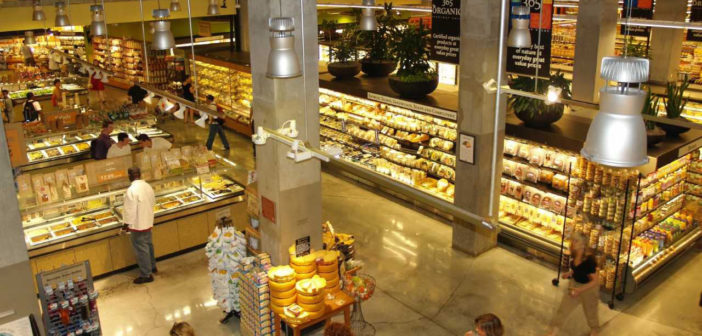By:Marie Umholtz
Amazon closed its 13.7 billion dollar deal with Whole Foods Market on Monday, Aug. 28, 2017. Whole Foods, known as a
pricier, upper-end retailer, began to cut prices that same day. Before the acquisition, Whole Foods competed in the grocery market with its corporate values and quality products. Many customers were willing to pay a higher price for natural, organic, and responsibly sourced groceries at a company that takes pride in its values of health, community, and sustainability. Whole Foods catered to a rather small pool of customers, but Amazon is working to bring in more customers with the promise of major price cuts and a rewards program for Prime members. Along with this price cut, Amazon is beginning to offer Whole Foods’ private brand products online. In his CNBC article, Joseph Cherian, assistant chair and teaching professor in the Department of Marketing at the University of Notre Dame, wrote, “according to estimates only 34 percent of U.S. households live within 5 miles of a Whole Foods store; a good number of consumers in the other two-thirds could be interested in purchasing Whole Food’s private label products.” The deal not only opens more affordable and available options for quality and organic produce within Whole Foods, but also pushes for competition with other retailers, like Walmart. Walmart is partnering with Google to improve customer service with more digital options. According to NPR, Walmart’s products will be available on Google’s shopping service, Google Express.
NPR elaborated, “Walmart customers will be able to place an order by simply saying it out loud, using either the Google Assistant app or the voice-activated speaker Google Home.”
Mark Lore, president and CEO of Walmart U.S. eCommerce, said in Walmart’s blog, “This will enable us to deliver highly personalized shopping recommendations based on customers’ previous purchases, including those made in Walmart stores and on Walmart.com. To take advantage of this personalization, customers only need to link their Walmart account to Google Express.”
Lore acknowledges that these innovations will spark competition and comparison, and he explained, “We know this means being compared side-by- side with other retailers, and we think that’s the way it should be. An open and transparent
shopping universe is good for customers.” Dr. Keith Jones, a professor of marketing at Saint Leo University with about 10 years of experience in retail, explains that he prefers to consider value over price competition.
In addition, he projects that these competing companies and their broadening platforms will be able to improve customer experience and offer consumers a greater range and variety of available products. Jones said retail needs to adjust to digital platforms because many consumers prefer “showrooming,” where they look at a product in person before purchasing online, and the use of “omnichannels,” which is where multiple platforms are made in a purchase decision. Also, Cherian does not expect this adjustment to take off in the long run. For example, Amazon will install lockers in Whole Foods locations for customers pick up or return purchase, which he believes won’t improve shipping services. “Most [customers]would rather have their Amazon order delivered to their doorstep than making a trip to Whole Foods.
Shipping is free either way,” said Cherian in the CNBC article. It is also argued that the company cultures of Amazon and Whole Foods differ too much to work well together. According to another CNBC article, there is a glaring problem with the acquisition due to the difference between Amazon and Whole Foods. “One of the key lessons from decades of academic research on mergers and acquisitions (apart from the little-known fact that deals tend to fail at least as often as they succeed) is that related diversification tends to outperform unrelated diversification,” said Craig Crossland, associate professor of business at Notre Dame in the CNBC article he wrote. “Amazon’s is a culture of relentless, largely impersonal, efficiency, while Whole Foods has positioned itself as an organization that not only provides healthier, natural food, but also represents ‘enlightened’ values.” However, Jones thinks these innovations and culture differences will create a better customer experience. He explained that the lockers, for example, will eliminate the hassle of shipping and returning items purchased online. Similarly, Jones believes that differences in corporate cultures could help both sides of the merger in the long run. “I think we’ll see Amazon try to establish or maintain certain pieces of the [Whole Foods] culture. The high-quality product will still be there, but with Amazon’s purchasing power, they’re going to change the distribution system, the piece of it that the consumer doesn’t see. They’re going to be able to get product in there at a less expensive price.”
By adopting Whole Foods values, Amazon can combine a pleasant customer experience with its own efficiency and low- cost appeal, as Jones said, “What they’ll have to drive home is ‘why, other than price, should I come to your store?’ That’s where the value piece of Whole Foods comes in.” The new acquisition is met with both positive and negative feedback and outlooks for the future, but it will allow both parties the opportunity to evolve and combine their differences to create new approaches that could shape the retail industry. It has sparked innovative competition with other major retailers in the market, and only time will tell how these changes will shape the future of retail.





